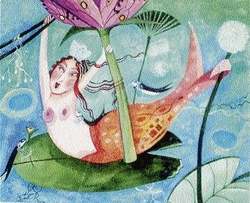Delightful art satire
Published: Sunday | April 8, 2007

Melisande Potter's 'School of Suitors'. - Photo by Anthea McGibbon
Anthea McGibbon, Gleaner Writer
AFTER SIX years, Melisande Potter once again colours the north coast with her humour. Over 30 of her pieces are this month's pick of good art offered at the Harmony Hall mecca.
At the same time, Alexander Cooper focuses on depicting the seriousness of Easter in three pieces, which collectively could be titled 'Beast of Burden', at his Cooper's Hill hideaway.
Potter, in her latest exhibition titled 'The Guardian of Unearthed Delights', deals with the reality of reality by offering antidotes against life's negatives. The display is a welcome comfort to deal with the recent loss of four stalwart supporters of Harmony Hall - Dee Harris, Beth Jacobs, Dorothea Whitehorne and Colin Garland.
The works have all the chime of a good nursery rhyme, but on closer examination doses of humour are administered through the fairyscape images.
Although not hailing from an artistic family, Potter has flirted with many art forms. She has played the piano, been a ballet dancer and even founded the Mystic Paper Beast (a mask and mime theatre group), in addition to her visual manipulations, which began when she married into a family of visual artists. This exposure and experience in the combined arts have roots in the support of her family, who nurtured her exceptional abilities. Potter attended Harvard University (piano concert) and Longy School of Music (music theory).
Back in 1987, she came to Jamaica as a performing artist and her skills were further cultivated by Jamaican professionals, such as Rex Nettleford, Brian Heap and Olive Lewin.
Enthusiasm
Guest speaker at the exhibition's opening, Paul Issa, described the collection as "a delight". Critiquing the works as a sublime blend of "wit, sophistication and navet", Issa said that her paintings always cheered him up. Through engaging, descriptive words, he guided viewers around the exhibition, infecting them with his enthusiasm as he said the works "are always a joy to have around".
He first came across Potter's work during the 1980s, when a number of her paintings had been purchased by the Issa family's Couples Ocho Rios hotel, and he is still spellbound. The businessman, who is still attempting to unravel the secrets of the spell, has personally collected several pieces of Potter's work, as well as her books Ptolemy, The Turtle and Soon Come, written particularly for Jamaica's children.
Potter describes her works as a series of allegories, and the works reflect her witty intellect. The artist says she is sometimes influenced by the world's micro cosmos and Persian miniatures, as evidenced in 'Virgin Wool', which is a 'black' depiction of the Virgin Mary. In 'Country Taxi', a Jamaican boy hitch-hikes on the back of a mythological bird. Along the way there are musical notes to which the trees bend and the flowers dance. This could mean the happy youth moving towards life's hilly pathways which he wishes to explore. In 'Seaside Holiday' there is a large flip-flop slipper, an effective sun blocker for the littering happy-go-lucky life-size insects. A queen bee observes her subjects, other insects, from her clamshell seat, as they enjoy the shore around the sandcastle. Clever and attractive 'Brush Men' is clever and attractive. Five community members militantly walk with larger-than-life scaled paintbrushes seemingly towards a river flowing through an expansive field just behind the large banana leaf overpowering the foreground of the illustration, as if ready to paint the world. 'Moon's Observations' depicts the moon watching a young girl carrying a basket of eggs just laid by the hen she follows. Travelling alongside her are ants carrying a sharp knife, perhaps for a midnight picnic. Held by his parents, a newly born angelic Easter bunny is protected by a glowing halo, surrounded by the flowers spreading their blooming petals - an ideal illustration of Easter glory in 'Angel Bunny'. 'Threads of Nature' depicts two butterflies relying on each other for support in mid-air. They grasp at a banana leaf which unravels, thread by thread, by the pull of their weight. Two masks - 'Eleanor' and 'Lulu's reminisce on Potter's theatre days. Through her mostly gouache works, fabric such as plaid material and foil is used to add or depict texture, such as in 'Milky Way', where Jamaican angels pattern the starry sky. Her work brings together personal and observed experiences in a wealth of riddles that can be enjoyed forever. Away from usual The latest Easter works by Alexander Cooper are a welcome step away from his usual commentary on Jamaica. In all three the biblical beast of burden - the donkey - cleverly depicts the Easter message. In the first, one single donkey assists a dying Christ in carrying His burden. The dying Christ is depicted in blue, representing the peace that is being hoped for the world. The blue, however, provides movement and contrast against the confusion and reminds us that in Christ there is hope to overcome and live among and above obstacles. In the second panel, two donkeys are moving away from a viewer and in unity carry the cross. They too are painted in ultramarine, and move towards a burst of light, symbolising new birth, offered by the Resurrected Christ. However, in the final panel, the two donkeys move in opposite direction and achieve nothing, but a heavier burden as they operate in oblivion of the circle of hope that awaits them. The blue tones are tainted and uneven, representing the disturbance of peace, when man and his companion move at odds with each other. The colours representing hope are illustrated static, being untapped hope. Both artists are witty and differing in technique and style, are parallel in the message of hope sent with assurance. Anthea McGibbon, a graduate of the Edna Manley College of the Visual and Performing Arts, has more than 10 years' experience in the fields of journalism and the arts. Contact her at islandartattack@yahoo.co.uk or anthea.mcgibbon@gleanerjm.com.
